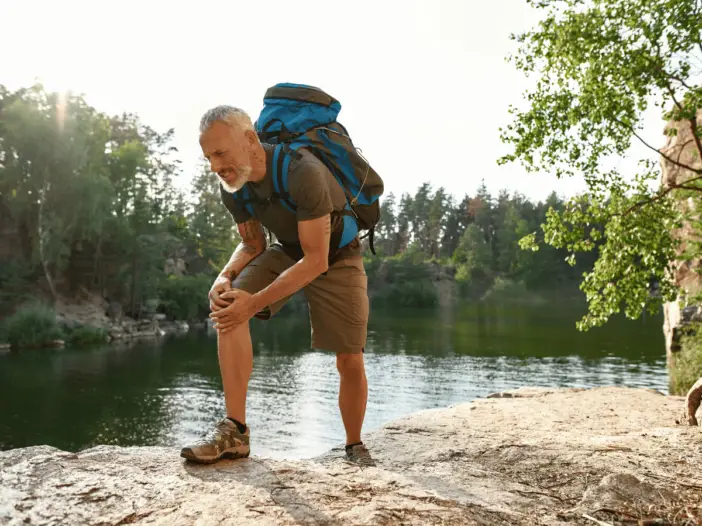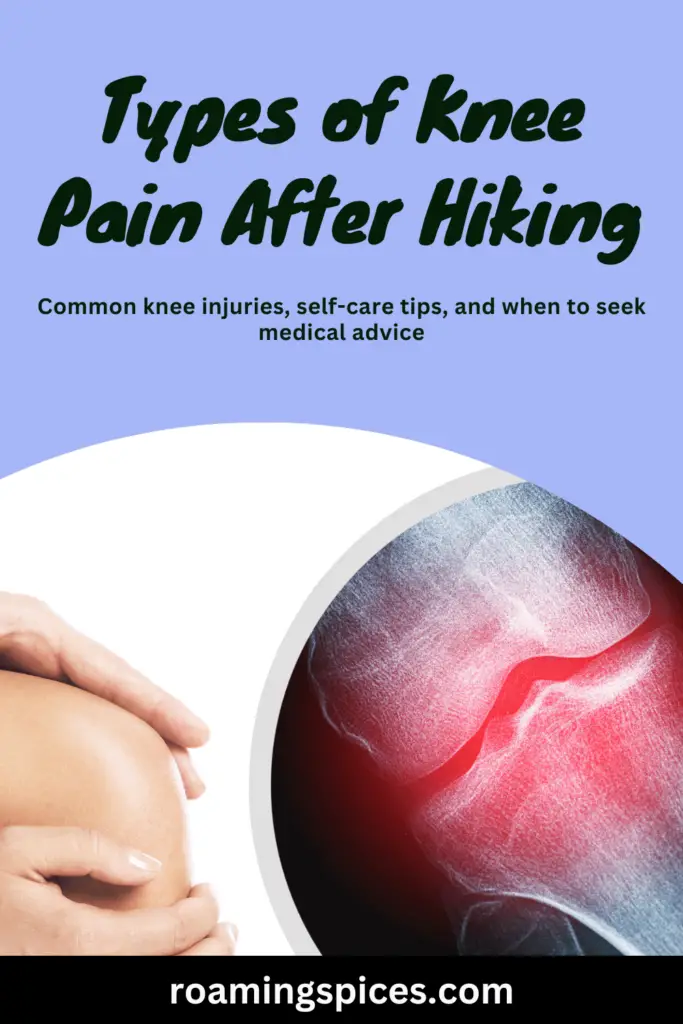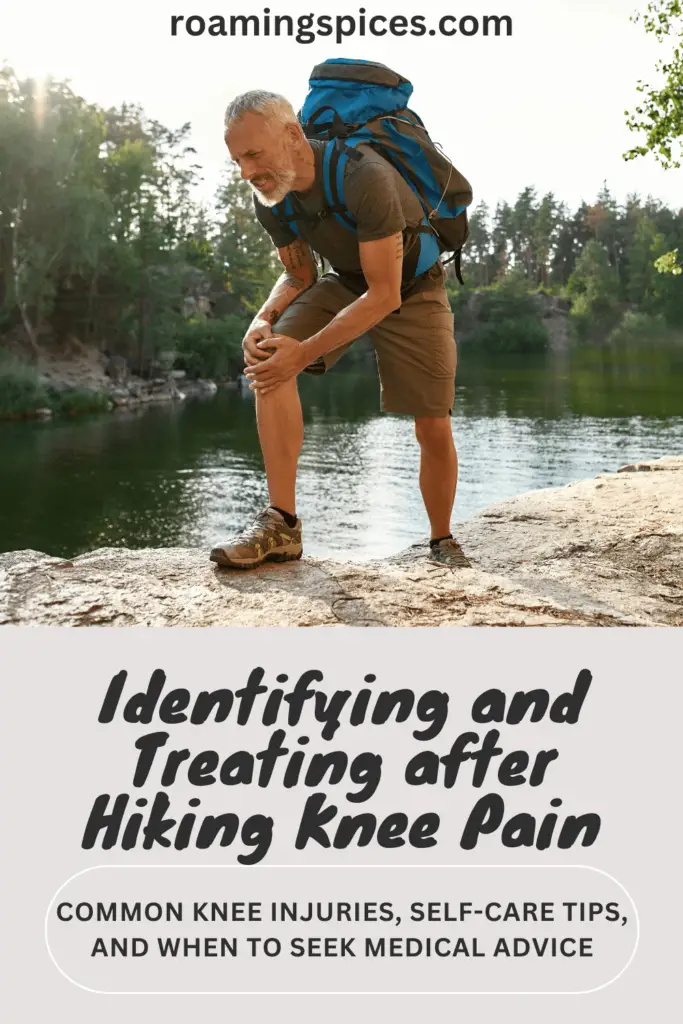
Health & Fitness
After hiking knee pain is a common concern for outdoor enthusiasts, often stemming from the rigorous demands of the trail. This guide explores effective strategies to prevent, manage, and seek treatment for those troublesome post-hike knee discomforts, ensuring your adventures remain pain-free
Knee Pain After Hiking
Hiking is a rewarding and stimulating outdoor activity, allowing us to explore breathtaking landscapes and connect with nature. However, the strenuous demands of hiking can sometimes lead to post-hiking knee pain, which can vary in type and intensity.
This article delves into the world of after-hiking knee discomfort, shedding light on the types of knee pain that hikers might encounter on their journeys.
Understanding these distinct knee pain forms is crucial for novice and seasoned hikers. We’ll explore each type’s causes, symptoms, and preventative measures, helping you effectively identify and address knee pain.
Whether you’re facing an acute issue like patellofemoral pain syndrome or chronic discomfort, this comprehensive guide will equip you with the knowledge needed to enjoy hiking while safeguarding your knee health.
Understanding Post-Hiking Knee Pain
Post-hiking knee pain can manifest in various forms, from mild discomfort to more severe issues, and it’s essential to recognise and address these symptoms.
By comprehending the underlying causes and different types of post-hiking knee pain, hikers can take proactive steps to minimise risk and manage discomfort.
This knowledge empowers outdoor enthusiasts to make informed decisions about their hiking routines, gear, and techniques, ultimately enhancing their safety, enjoyment, and overall experience.
Understanding post-hiking knee pain is the first step toward a healthier and more sustainable hiking journey, whether you’re a seasoned trekker or a novice hiker.
Acute vs. Chronic Pain: The Key Distinctions
Understanding the distinction between acute and chronic pain is pivotal for effectively managing and preventing post-hiking knee pain.
Acute Pain: Short-term pain typically occurs suddenly, often due to a specific incident during or immediately after a hike. Acute knee pain may be caused by a slip, trip, or misstep, as well as excessive stress on the joint during challenging descents or uneven terrain.
It’s generally sharp and intense, with a clear and identifiable trigger. Rest, ice, elevation, and over-the-counter pain relievers can help alleviate acute pain.
Chronic Pain: In contrast, chronic knee pain is persistent and long-lasting, often extending beyond the immediate post-hike period. It might result from cumulative stress and strain on the knee joint over time, improper hiking techniques, or underlying conditions.
Chronic pain tends to be dull and persistent and can significantly impact one’s quality of life. Managing chronic pain often requires a more comprehensive approach, including physical therapy, lifestyle adjustments, and medical intervention.
Recognising the key differences between these types of knee pain is essential for choosing the appropriate treatment and prevention strategies.
While acute pain can often be managed with rest and self-care, chronic pain necessitates a more in-depth and sustained approach to ensure the continued enjoyment of hiking without persistent discomfort.
Common Causes of Post-Hiking Knee Pain
After hiking knee pain can arise from various common causes, making it essential to pinpoint the root issues for effective prevention and management:
Overuse and Overexertion: Prolonged or strenuous hikes, especially on challenging terrain, can lead to overuse of the knee joint, causing discomfort.
Improper Footwear: Ill-fitting or inadequate hiking footwear can contribute to knee strain and instability during a hike.
Inadequate Conditioning: A lack of physical preparation, such as weak leg muscles or poor flexibility, can stress the knee joints.
Inadequate Warm-Up: Please warm up before a hike to avoid stiffness and muscle imbalances that can lead to knee pain.
Incorrect Technique: Poor hiking form and biomechanics, such as an improper stride or posture, can cause undue knee stress.
Tight or Weak Muscles: Imbalances in the quadriceps, hamstrings, or calf muscles can affect knee alignment and function.
Trail Conditions: Uneven or steep trails, rocky terrain, and long descents can contribute to knee strain and injury.
Excessive Weight: Carrying a heavy backpack or hiking gear that isn’t distributed correctly can stress the knees.
Understanding these common causes is the first step toward effective prevention. By addressing these factors through proper conditioning, technique, gear choices, and trail awareness, hikers can reduce their risk of experiencing post-hiking knee pain and enjoy a more comfortable and enduring hiking experience.
Patellofemoral Pain Syndrome (PFPS)
Patellofemoral Pain Syndrome (PFPS), often called “runner’s knee,” is common among hikers and outdoor enthusiasts. This condition primarily affects the patellofemoral joint, where the kneecap (patella) meets the thigh bone (femur). Due to their activity’s repetitive and strenuous nature, Hikers are susceptible to PFPS.
PFPS typically manifests as a dull, aching pain around or behind the kneecap, particularly when descending steep slopes or after extended hikes. The underlying causes can vary but often include muscle imbalances, improper tracking of the patella, or overuse of the knee joint.
It’s crucial for hikers to recognise the symptoms and understand the importance of addressing this issue promptly.
Management of PFPS involves rest, physical therapy to correct muscle imbalances, and adjustments to hiking technique, including using trekking poles for stability. Incorporating strength and flexibility exercises into your routine can help prevent PFPS and ensure your hiking experiences remain enjoyable and pain-free.
Iliotibial Band Syndrome (ITBS)
Iliotibial Band Syndrome (ITBS) is a well-known challenge for hikers. This condition arises due to the inflammation and irritation of the iliotibial band, a thick band of connective tissue running from the hip down to the shin, which rubs against the outer knee during movement.
Hikers are particularly prone to ITBS because of the repetitive knee flexion and extension inherent in the activity, especially during descents and on uneven terrain.
ITBS often manifests as a sharp, burning pain on the outer side of the knee, particularly during downhill hikes. To mitigate ITBS, hikers should strengthen hip and thigh muscles, stretch the iliotibial band, and maintain proper hiking form.
The proper footwear, such as shoes with adequate arch support and cushioning, can also help prevent or alleviate ITBS. Proactive measures are essential for avoiding this painful condition and ensuring that hikers can relish their outdoor adventures without knee discomfort.
Meniscal Injuries
Hiking is a beloved outdoor activity, offering a wealth of natural beauty and physical exercise. However, it’s not immune to potential pitfalls, including meniscal injuries that can lead to bothersome after-hiking knee pain.
The meniscus, a vital cushioning cartilage within the knee, can become strained or torn during hiking adventures, especially when navigating challenging terrains or enduring sudden twists. After hiking, knee pain often emerges as a persistent reminder of the wear and tear experienced on the trail.
Preventing meniscal injuries while hiking necessitates suitable footwear, using trekking poles for enhanced stability, and practising proper form. Strengthening leg muscles and ligaments through regular exercise can reduce the risk of knee injuries.
Furthermore, paying attention to the terrain and walking cautiously will help hikers safeguard their knees and ensure a pain-free experience during and after their hiking escapades.
Ligament Sprains and Strains
Hiking offers the thrill of adventure and exploration but can also lead to ligament sprains and strains, often resulting in after-hiking knee pain. The ligaments in the knee, like the anterior cruciate ligament (ACL) or the medial collateral ligament (MCL), can be stressed when navigating uneven terrain or making abrupt movements on the trail.
These injuries can cause discomfort, swelling, and instability in the knee joint, making post-hike knee pain a common complaint.
To minimise the risk of ligament injuries while hiking, it’s essential to wear supportive footwear and maintain proper hiking techniques, including cautious foot placement and trekking poles for added stability.
Conditioning your leg muscles through regular exercise can also enhance knee joint stability and reduce the likelihood of strains or sprains. Paying attention to your body’s signals, including any post-hike knee discomfort, is crucial for early intervention and recovery, ensuring that hiking remains an enjoyable and safe outdoor activity.
Treatment and Prevention Strategies
After hiking knee pain can be a nuisance, but several effective treatment and prevention strategies keep your knees in tip-top shape for future outdoor adventures.
Rest is crucial when dealing with post-hike knee discomfort to allow your joints to recover. Applying ice and elevating the affected area can help reduce inflammation and alleviate pain. Over-the-counter pain relievers can also provide temporary relief.
Prevention is equally important. Strengthening the muscles around the knee through targeted exercises can provide better support and stability.
Investing in high-quality hiking boots with good arch support and shock-absorbing soles can significantly reduce the strain on your knees during hikes. Proper warm-up, stretching before hiking, and maintaining good posture and gait during your adventure can further prevent knee pain.
If knee pain persists, consult a healthcare professional for a proper diagnosis and personalised treatment plan to ensure your hiking experiences remain enjoyable and pain-free.
When to Seek Medical Advice
After hiking knee pain is common, but it’s essential to recognise when this discomfort requires medical attention. While some soreness and mild pain can be managed with rest and self-care, there are situations where you should seek medical advice:
Persistent Pain: If the knee pain doesn’t subside after a reasonable period of rest and self-treatment, it’s a clear sign to consult a healthcare professional.
Swelling and Inflammation: If your knee is visibly swollen, inflamed, or feels warm to the touch, it might indicate a more severe issue, such as a ligament tear or an underlying medical condition.
Instability or Popping Sounds: If your knee feels unstable or produces unusual popping sounds, it could indicate ligament or cartilage damage that warrants medical evaluation.
Limited Range of Motion: When you experience a significant decrease in your knee’s range of motion or difficulty bearing weight on the affected leg, consult a doctor promptly.
Recurrent Pain: If you’ve had repeated episodes of after-hiking knee pain, it might indicate an underlying issue that requires professional assessment to prevent further damage.
In cases where knee pain persists or worsens, seeking medical advice ensures a proper diagnosis and timely intervention to preserve your knee’s long-term health and maintain your ability to enjoy outdoor activities like hiking.
The spectrum of after-hiking knee pain is diverse, and understanding its nuances is vital for outdoor enthusiasts. From the common meniscal injuries to ligament strains, knee discomfort can vary in intensity and cause. Recognising the type of pain you’re experiencing is the first step in effective self-care and prevention strategies.
While many instances of post-hike knee pain can be managed with rest, ice, and over-the-counter remedies, it’s crucial to acknowledge the warning signs that demand professional medical attention. Persistent or worsening pain, swelling, instability, and recurrent discomfort should not be ignored.
Ultimately, staying mindful of your body, adopting good hiking techniques, and strengthening your knee’s supporting structures can significantly reduce the risk of after-hiking knee pain.
Feel free to consult a healthcare professional for a thorough evaluation when in doubt. With proper care and preventative measures, you can continue to relish the joys of hiking while safeguarding your knee’s well-being.
Like Our Article? Please Pin it!



Leave a Reply